It is well known that grazing is the horse’s natural way of obtaining its food. If I asked you what they eat when grazing your answer would likely be grass. Generally you would be right in your assumption. What if there are other more harmful plants lurking in the pasture, would you know which they were? Some of these toxic weeds can have a direct effect immediately and others cause damage that has an irreversible cumulative effect on the horse.
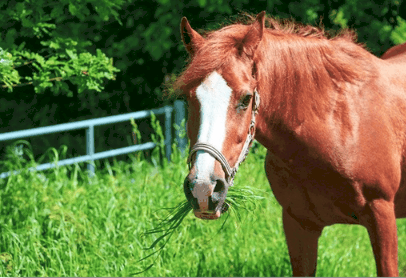
It has to be said that not all weeds are toxic and some can be beneficial, but they often compete with the nutritious grasses and can reflect the poor health of the soil itself.
Frustratingly, the damage caused by ingesting Ragwort is cumulative and non-reversible so by the time symptoms are apparent in the horse, the disease is already very advanced; effective treatment is difficult and often impossible.
Ragwort
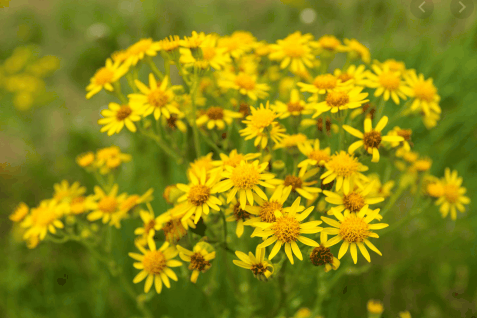
Most people if asked for a list of toxic weeds would likely start with Ragwort. It’s one that we as horse owners are generally well aware of. There are 4 different types that are common in Ireland and it is covered under the noxious weed act; as such land owners are legally responsible for its control. The most common is Senecio Jacobaea or common ragwort; it is a biannual taking 2 years to grow and flowers in the second year. When green and growing it has a very bitter taste due to the alkaline nature of plant, which is a survival technique to prevent it being eaten and allow it to reach maturity and reproduce. The problem comes when it is dead, either in winter when horses are left out and are hungry; or contained in hay. At this point it loses its bitter taste and horses will eat it. The alkaline substance is still present in the form of pyrrolizidine alkaloid toxin that typically results in the delayed onset of chronic, progressive liver failure. Frustratingly, the damage is cumulative and non-reversible so by the time symptoms are apparent, the disease is already very advanced; effective treatment is difficult and often impossible. The start of the disease may even pre-date the current ownership of the animal.
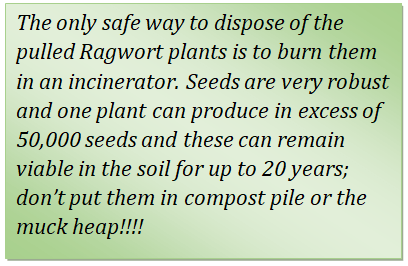
Effective control of a low grade infestation can be achieved by pulling the individual plants. This must be done before they flower and spread seed; it needs to be carried out on an ongoing basis. The pulled material must be removed from the field so as not to be a hazard. The only safe way to dispose of the pulled plants is to burn them in an incinerator. Seeds are very robust and one plant can produce in excess of 50,000 seeds and these can remain viable in the soil for up to 20 years; don’t put them in compost pile or the muck heap!!!! In heavy infestations chemical control by a licenced contractor may be the only option but is likely to be on going due to the dormant seeds; we are still left with dead material as a hazard if spraying is left late in the growing season. Ploughing and reseeding can be effective if combined with post emergence spraying that is then done annually until hand pulling becomes a practical option.
Bracken tends to affect the nervous system. The enzyme Thiamase contained in the bracken is known to be destructive to thiamine (vitamin B1), and Deficiency of this vitamin will lead to neurological problems. If caught and treated early the recovery is reasonably good.
Bracken
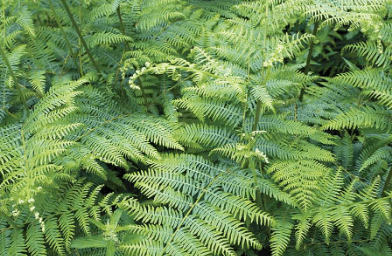
Another of our toxic plants that can encroach where horses and ponies graze is Bracken. Often abundant on hill grazing it can also be found in hedges and wooded areas. Bracken or Pteridium aquilinum can be very invasive and difficult to eradicate from land. It grows from a network of rhizomes in the soil and these can spread underground over large areas, as well as spoors spread from the underside of the leaves. Removing the above ground foliage is not totally effective due to the underground root system. However aggressive cutting and spraying with a systemic herbicide has been shown to have some control.
Like ragwort it is generally not eaten by choice but more likely eaten if there is a shortage of grass. Bracken starts to grow early in spring often before the grass and the bright green shoots may be nibbled on; sometimes it can get bailed up in hay and ingested that way. The horse needs to ingest about 25% of daily ration over several months to be affected; the more it eats the quicker the effect happens.
Bracken tends to affect the nervous system. The enzyme Thiamase contained in the bracken is known to be destructive to thiamine (vitamin B1), and Deficiency of this vitamin will lead to neurological problems. If caught and treated early the recovery is reasonably good.
Field Horse Tail
Field horse tail also contains Thiamase; it has the same effect as bracken but very different to look at. Field horse tail (Equisetum arvense) is also referred to as; mare’s tail and bottle brush plant. It grows in damp conditions and is often found around streams where soil has a high content of sand or gravel.
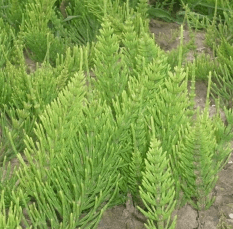
Like bracken it has an extensive root system allowing it to spread over large areas. To add to its invasive properties it is also spread via spores but it only takes a finger sized piece of root or stem for horsetail to regrow. No wonder this plant has survived for millions of years and was around long before the dinosaurs. Pulling and cutting are not an option for control; It can however be controlled with repeated spraying although “controlled” is the operative word not eradicated. Drainage and raising the ph of the soil by adding lime has shown results; but must be ongoing to be effective. Once again rates of 25% of the ration over several months will be needed to produce symptoms. Early treatment is the key to recovery.
It has a tough structure with high silica content and tends not to be foraged by choice but more by necessity when there is no other grazing in winter. It may get incorporated into hay and get consumed in that way.
Foxglove
Cultivated as a garden plant for its tall flower spike the Foxglove (Digitalis purpurea) grows wild in woodland and around hedge rows where it takes advantage of protective shade from the sun. It is a biannual and flowers in its second summer reproducing by seed from this flower. Every part of this plant is toxic. Both when living, and when dried. It contains compounds called cardiac glycosides that affect the heart. In minute doses Cardiac glycosides are used for treating heart failure and certain irregular heartbeats. The real issue with these killers is it only needs about 100g to be eaten to prove fatal within a few hours. As death has a fast onset recovery is from ingestion of foxglove is unlikely.
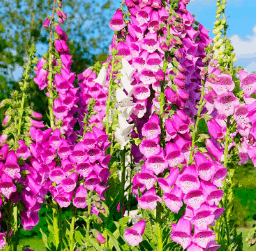
Fresh Foxgloves are unpalatable and only likely to be nibbled on if no other forage is available, but unfortunately they are more palatable in hay where they may be eaten. Control by cutting and removing as they appear on an annual basis and they should be easily eradicated. Alternatively spray with a systemic herbicide and remove once dead. Clumps can also be dug up and removed.
Deadly Nightshade
Used for centuries in homeopathic medicines Deadly nightshade (Atropa belladonna) contains poisonous atropine and scopolamine in its stems, leaves, berries and roots. It is a perennial plant and is found in meadows, hedges and along verges. While it is not a forage of choice it can be consumed when dried and bailed in hay.
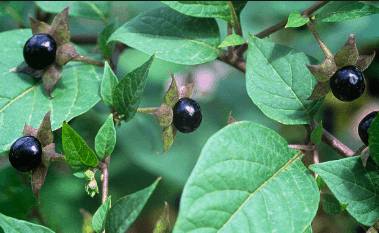
Consumption of deadly nightshade affects the nervous system: it paralyzes nerve endings in the involuntary muscles of the body, such as the blood vessels, heart and gastrointestinal muscles. Producing a variety of symptoms ranging from; depression, excitability, colic, neurological signs, poor coordination, weak muscle function and death from heart failure, all depending on how much has been eaten. While no figures were available for how much would kill a horse, going on the basis that 10 berries will kill an adult then you could assume that 70 to 80 could kill a horse. Very approximate but the level of toxin varies in the plant according to age and weather conditions. Best to say eradicate it and not take the chance of any being eaten. It can be dug up or sprayed, be careful to wear gloves when handling it and not to spread berries.
It is always best to check your paddock for your horse on a regular basis, to ensure that there are no poisonous weeds present. We have a picture with our Top 5 Killer Weeds that are Poisonous to Horses Below, this will help you identify the culprits.
Check Out Our Top 5 Killer Weeds That Are Poisonous To Horses in the Picture Below;
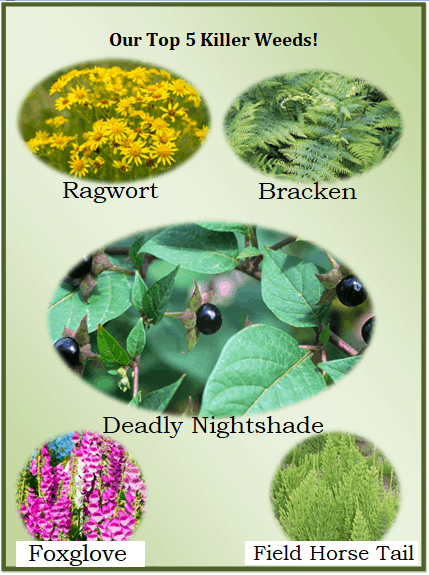
This article was written by Jessica Soley BHSI and was originally published in the July 2020 Issue of Irish Sport Horse Magazine.
